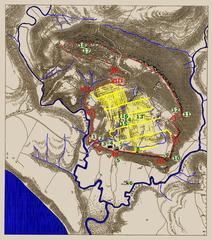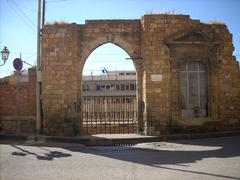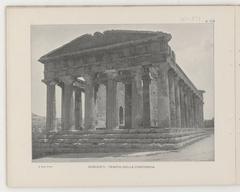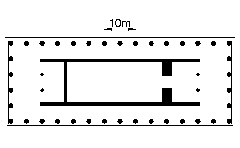Ekklesiasterion of Agrigento: Visiting Hours, Tickets, and Historical Sites Guide
Date: 14/06/2025
Introduction
The Ekklesiasterion of Agrigento, located in the heart of the Valley of the Temples archaeological park, is a rare surviving example of an ancient Greek assembly hall. Unlike the renowned temples that symbolize religious devotion, the Ekklesiasterion was the civic stage where citizens of Akragas (modern Agrigento) gathered to debate, vote, and shape their polis. This unique site not only embodies the democratic practices of Magna Graecia but stands as a testament to the integration of civic, political, and religious life in ancient Sicily.
This comprehensive guide explores the Ekklesiasterion’s historical context, architectural features, cultural significance, and provides all the practical information needed for a rewarding visit, including tickets, opening hours, accessibility details, and travel tips. For the most reliable and updated information, refer to the official Valley of the Temples website and leading guides such as Audiala, Stories by Soumya, and Agrigento Guide.
Table of Contents
- Introduction and Historical Significance
- Origins and Historical Context
- Architectural Features and Function
- Role in Ancient Civic Life
- Cultural and Philosophical Heritage
- Preservation and Modern Recognition
- Visiting the Ekklesiasterion: Practical Information
- Enhancing Your Visit: Tips and Itineraries
- Frequently Asked Questions (FAQ)
- Conclusion and Visit Recommendations
- Sources and Further Reading
Origins and Historical Context
Founded in 581 BCE by settlers from Gela, Akragas rapidly developed into a major center of Magna Graecia (audiala.com). The Ekklesiasterion, built between the 4th and 3rd centuries BCE, was a focal point for civic life. As the official meeting place for free male citizens, it echoed the democratic traditions of Athens, providing a platform for public debate, voting, and collective decision-making (archmaifil.wordpress.com).
Its creation coincided with a period of political transformation in the Greek world. The Ekklesiasterion’s proximity to sacred sanctuaries highlights the close relationship between civic and religious spheres in ancient Sicily (archmaifil.wordpress.com). The presence of this civic monument in Agrigento underscores the city’s commitment to participatory governance.
Architectural Features and Function
The Ekklesiasterion distinguishes itself with a semi-circular seating arrangement carved directly into limestone bedrock, accommodating up to 3,000–4,000 citizens (archmaifil.wordpress.com). Its plan resembles a small theater but lacks the typical skene and orchestra, focusing instead on a central area for speakers (bema). This functional design prioritized clear sightlines and audibility, essential for public assemblies.
Civic assemblies took place here, and the structure continued its role as a comitium during the Roman period, highlighting the continuity of collective decision-making in Agrigento’s governance (archmaifil.wordpress.com).
Role in Ancient Civic Life
The Ekklesiasterion was the epicenter of Akragas’ political activity. Free male citizens convened to deliberate on legislation, policy, military matters, and the election of magistrates (lostandfoundinitaly.com). This participatory model distinguished the city from societies ruled by a select elite and fostered a strong sense of civic identity. The structure’s existence in Agrigento reflects the city’s lasting role as a center of Mediterranean democracy (archmaifil.wordpress.com).
Cultural and Philosophical Heritage
Agrigento’s Ekklesiasterion was more than an assembly space—it was a cradle of intellectual discourse. The city was home to Empedocles, a pre-Socratic philosopher who shaped Western thought (lostandfoundinitaly.com). Assemblies often began with rituals and offerings to the gods, underscoring the connection between civic actions and divine will (archmaifil.wordpress.com). This integration of sacred and civic life is a defining trait of Greek city-states and is vividly reflected at the site.
Preservation and Modern Recognition
Today, the Ekklesiasterion is a protected feature of the Valley of the Temples, a UNESCO World Heritage Site (audiala.com). Although less monumental than nearby temples, its historical significance is immense. Archaeological research and ongoing conservation ensure the site’s accessibility and interpretive value. Informational panels, digital media, and guided tours help visitors appreciate its civic function and relevance (nationaltraveller.com).
Visiting the Ekklesiasterion: Practical Information
Opening Hours
- The Valley of the Temples, including the Ekklesiasterion, is open daily from 8:30 AM to 7:00 PM.
- Last entry: 1 hour before closing.
- Extended summer hours may apply; check the official park website for updates.
Tickets and Prices
- Standard adult ticket: Approximately €12.
- Reduced rates for EU citizens aged 18–25.
- Free entry for children under 18.
- Combined tickets available for the Valley and the Regional Archaeological Museum (Agrigento Guide).
Getting There
- The site is 3 km from Agrigento city center.
- Reachable by local bus, taxi, or car (parking available).
- Shuttle buses and e-scooters are available within the park (Stories by Soumya).
Accessibility
- Main paths are well-maintained but can be uneven; sturdy footwear recommended.
- Wheelchair users may need assistance. The museum is fully accessible.
- Contact the park in advance for specific needs (Valley of the Temples official website).
Travel Tips
- Visit in spring or fall for comfortable weather and fewer crowds.
- Early mornings or late afternoons offer cooler temperatures and ideal lighting for photography.
- Bring sun protection, water, and comfortable shoes.
- Guided tours provide expert insights and can be booked online or at the site.
Enhancing Your Visit: Tips and Itineraries
- Combine with the Archaeological Museum: The museum houses over 5,000 artifacts, including finds from the Ekklesiasterion (Agrigento Guide).
- Attend Cultural Events: Especially during Agrigento’s 2025 Italian Capital of Culture celebrations, including concerts and night tours (Great Sicily).
- Suggested Itinerary: Begin at the museum and Ekklesiasterion, continue along the main archaeological trail, and end with sunset at the Temple of Concordia.
- Nearby Attractions: Temple of Juno, Temple of Heracles, Kolymbethra Garden, and the Church of San Nicola.
Frequently Asked Questions (FAQ)
Q: What are the Ekklesiasterion visiting hours?
A: Generally 8:30 AM–7:00 PM, with seasonal variations. Confirm on the official website.
Q: How much are tickets?
A: €12 for adults, discounts for youth, and free for children under 18. Combined tickets are available.
Q: Is the Ekklesiasterion accessible for people with disabilities?
A: Partial accessibility; contact the park for specific assistance.
Q: Can I join a guided tour?
A: Yes, guided tours are available and highly recommended.
Q: What other sites should I visit nearby?
A: The Temple of Concordia, Archaeological Museum, Kolymbethra Garden, and Church of San Nicola.
Conclusion and Visit Recommendations
The Ekklesiasterion of Agrigento is a profound symbol of ancient Greek democracy transplanted to Sicily, offering an exceptional window into the civic and political innovations of Magna Graecia. Its architectural design, historical significance, and enduring legacy make it an essential stop for anyone interested in ancient history. Modern preservation ensures accessibility and educational value, while proximity to other celebrated sites enriches any visit.
To maximize your experience:
- Plan ahead using official resources.
- Consider guided tours for deeper context.
- Visit during off-peak hours for a quieter, more reflective atmosphere.
- Participate in cultural events during the 2025 celebrations for a unique perspective.
For further details and travel tips, consult the Valley of the Temples official website, and explore insights from Audiala and Great Sicily.
Sources and Further Reading
- Audiala – Visiting the Ekklesiasterion of Agrigento: History, Tickets, and Travel Tips, 2025
- Archmaifil Wordpress – Terze Classi
- Lost and Found in Italy – Agrigento Italy’s Capital of Culture for 2025: Where Ancient Legends Meet Modern Heritage, 2025
- National Traveller – Visit to the Valley of the Temples of Agrigento: How to Get There, Prices and Advice, 2025
- Stories by Soumya – Agrigento Valley of the Temples: A Guide, 2025
- Agrigento Guide – Officially Tour Guides Agrigento Museum, 2025
- Great Sicily – May 2025 Agrigento Italian Capital of Culture
- Parco Valle dei Templi – Valley of the Temples Official Website, 2025





